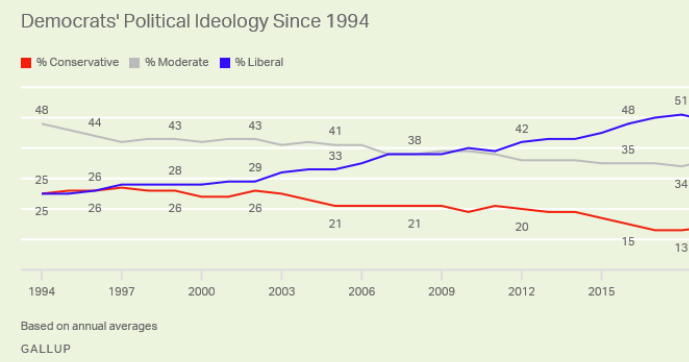As this answer neatly addresses the fact that historically the parties have been more polarized, I'd like to address the extent to which they are asymmetrically polarized now.
Yes, there is polarization. People who identify with different political parties do not agree on political ideas. But is there asymmetrical polarization? I don't think the data we have backs this claim up. In regards to exhibit A, the graph does not tell us much about any overall asymmetric political polarity between the parties. Since you included the Democratic graph, I'll include the Republican graph found here.

In 2017, there was a 64% difference between conservative and liberal identifying Republicans. Compare this to the graph of the Democrats you provided, where the internal party difference between conservatives and liberals, 38%, is growing more quickly than in the Republican party. However, the Republican party is already very polarized internally, so the Democratic party might just be catching up. And we can't directly apply these percentages to the graph of all American's ideological views, as that graph splits people into liberal, conservative, and independent, not Democrats or Republicans. So we are not able to address the asymmetric polarity of the US overall.
Now for exhibit B. I I believe these figures are from here, but I will be referencing the full report.
We know that overall, the ideological consistency of Americans is shifting left. The report includes this figure:

and provides the following explanation:
At the same time, the center of the scale has shifted in a somewhat liberal direction over time. To a
large extent, this is the result of the public’s growing acceptance of homosexuality and more
positive views of immigrants, shifts that are seen among both Democrats and Republicans (GOP
attitudes about immigrants are little changed over the last decade, but Republicans are
substantially less likely to view immigrants as a burden on the country than they were in the
1990s).
This is interesting, but it doesn't necessarily address why the median in the graphs you provide shifts left for the Democrats and does not shift either way for the Republicans. The issue is that there isn't one explanation for this. The shift left in the Democratic median could be because of increasing internal liberal consistency with the big ticket items, like homosexuality and immigration, but these are also increasing in the Republican party. The shift left could also be in part due to other more polarizing issues. The Republican median may not shift because of opposing effects in the change of views within the party. For example, more support for homosexuality, less support for environmental policies.
But to be clear, from these graphs and the analysis in the report, we don't know that there is asymmetric polarization. Nor do the authors apparently, as they avoid making any claim about asymmetry. What we do know is that there is more political polarization recently. And while there is evidence that since 2017 the number of Democrats identifying as liberal is increasing, this is not clearly causing asymmetric polarization.





